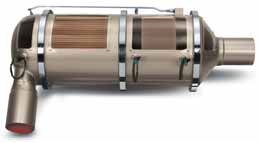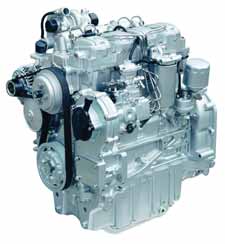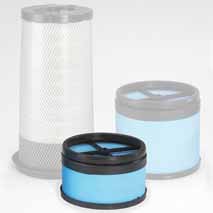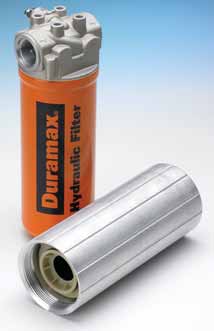 To comply with the U.S. Environmental Protection Agency’s Tier 4 Interim/European Union Stage IIIB emissions
To comply with the U.S. Environmental Protection Agency’s Tier 4 Interim/European Union Stage IIIB emissions
standards that take effect in 2011, off-highway mid-range diesels must have particulate matter reduced by 90% and
NOx by 45%
from current levels.
Although the Tier 4i deadlines are more
than 2-1/2 years away, engine builders
have been drawing and updating their
emissions technology roadmaps since
1996, when the EPA’s Tier 1 rules went
into effect. Several major engine suppliers,
including Cummins, Caterpillar, MTU
Detroit Diesel, Deere and Fiat Power Systems,
used the recently held CONEXPOCONAGG
trade show in Las Vegas (See
Equipment Gallery, p. 90) as a platform to
present their strategies for meeting the Tier
4i standards in their lower- and midrangehorsepower
products.
Cummins, for example, announced that
its Heavy-Duty QSX engine will be available
with a fully integrated intake-to-exhaust
scheme to meet Tier 4i regulations. The
Tier 4 QSX increases displacement to 16
liters and incorporates a high-pressure
common rail fuel system to enhance power
output and engine response.
New technology brings a significant
increase in QSX power output with an unrestricted
top rating of 650 hp (485 kW)
compared with 600 hp (447 kW) for the
current Tier 3 QSX. Ratings will extend
down to 400 hp (298 kW) to cover a range
of applications. Peak torque is increased
by 12% to 2,150 lb-ft (2.915 Nm) with
faster torque delivery available across the
engine rpm range.
“The next-generation Tier 4 QSX goes
beyond meeting very low emissions levels
to also offer higher levels of heavy-duty
productivity than the Tier 3 QSX,” said Ric
Kleine, vice president, Cummins Off-
Highway Business. “We have been able to
increase engine power and improve engine
response for Tier 4 by increasing displacement
and incorporating technologies such
as Cummins’ XPI High Pressure Common
Rail fuel system, a Variable Geometry
Turbocharger and the new Direct Flow air
filtration system. These subsystems are
designed to offer an equivalent level of
dependability to match that of the proven
Heavy-Duty QSX base engine platform.
“While cooled EGR is primarily employed
to reduce NOx emissions, we can
also utilize this process to influence the
combustion formula and realize fuel efficiency
improvements. This will achieve up
to 5% higher fuel efficiency for the Tier 4
QSX compared to Tier 3, depending on rating
and duty cycle,” said Kleine.
Cummins XPI fuel system enables multiple
injection events with very high fuel
injection pressure across all engine rpm
speeds to enable both cleaner combustion
and improved engine response. The XPI
fuel system is complemented by a
Cummins Variable Geometry Turbocharger
with a sliding-nozzle design. The
nozzle continuously varies the airflow boost
to match engine rpm and load demands.
According to the company, a particulate
filter replaces the muffler in the exhaust
stream and offers equivalent noise reduction
qualities. The filter is strengthened
against shock loads and vibration to meet
severe off-highway operating conditions.
Particulate matter collects on the filter and
is gradually oxidized by catalytic passive
regeneration. With some duty cycles, PM
accumulation rate may eventually exceed
oxidation rate, and a short active regeneration
is initiated by the engine electronic
control module utilizing the XPI fuel system
and Variable Geometry Turbocharger.
“Reducing Tier 4 installation complexity
for the equipment manufacturer has
been a key aim of our QSX development
program and we have been focused on
keeping the engine and particulate filter
envelope as space efficient as possible,”
said Susan Harrison, executive director,
Cummins Industrial Engineering.
 Cummins has significantly increased the power of its Tier
Cummins has significantly increased the power of its Tier
4-compliant QSX engine, with an unrestricted top rating of
650 hp (485 kW) compared with 600 hp (447 kW) for the
Tier 3 QSX.
The QSX is available with the new
Cummins Direct Flow air filtration system
by Fleetguard, developed for Tier 4 applications.
Direct Flow is claimed to offer a 35%
smaller installation profile than typical Tier
3 air filtration systems while maintaining
the same filtration efficiency. This is
accomplished by creating a direct-flow path
through the filter media which is packaged
in a rectangular configuration rather than a
conventional cylindrical shape. The Direct
Flow housing includes a sensor to monitor
temperature and pressure which sends data
to the engine electronic control module to
ensure optimum airflow operation.
MTU Detroit Diesel Goes
with SCR
Contrary to both Cummins and Cat,
Tognum’s MTU Detroit Diesel subsidiary
plans to use selective catalytic reduction
(SCR) and claims a high level of confidence
in the technology. The company displayed
at CONEXPO a Tier 4i-compliant Series
900 engine that uses SCR technology and
stated that its Series 900 and Series 500
engine families were ideal candidates for
the use of SCR to meet upcoming Tier 4i
emissions regulations. “These engines have
established themselves as the premier
engines in their power class,” said Scott
Jenkins, director of C&I Sales for MTU’s
North American division, MTU Detroit
Diesel. “And they have proven to perform
just as well with SCR.”
Emissions reduction often works in
opposition, explained Gerhard Kramer,
director, Industrial Application Center for
MTU. For example, reducing particulate
matter often increases the output of oxides
of nitrogen and vice-versa. “As designed,
the Series 900 and Series 500 engines
exhibit low particulate matter emissions,”
said Kramer. “To comply with NOx limiting
values, an SCR system is added.”
An SCR system works by injecting urea
into the exhaust stream where it reacts
with nitrous oxides to produce nitrogen and
water. This reaction takes place when the
urea and exhaust gases pass over a catalyst
material in the SCR unit. Urea consumption
varies with duty cycle and other factors
but is not expected to exceed 5% of fuel
consumption. As a rule of thumb, fuel consumption
compared with Tier 3 engines is
reduced by a similar amount, so that total
consumption of liquids remains the same.
The SCR system itself consists of
engine-mounted hardware, urea lines,
electrical wiring and a catalyst unit somewhat
larger than a muffler. The catalyst
unit is used instead of the standard muffler.
According to the company, service
trucks can re-supply off-highway equipment
with urea at the same time they refuel
the equipment.
“Other emissions reduction technologies
have merit and MTU has experience with all
of them,” said Jenkins. “Our philosophy is
to match the best technology to the needs of
the specific engine, and in this case SCR
was by far the best choice. We wanted to
take these proven engine families with stateof-
the-art designs, and bring them into compliance
with the next round of emissions
standards without compromising the benefits
the engines. SCR allowed us to do that
optimally by adapting the existing on-highway
technology for industrial use.”
Inline four- and six-cylinder Series 900
engines have ratings from 120 to 322 bhp
(90 to 240 kW), while V-configuration sixand
eight-cylinder Series 500 engines
cover ratings from 349 to 644 bhp (260 to
480 kW). The same SCR technology will
also be used in the related 460 inline sixcylinder
engine, which covers a power range
from 348 to 483 bhp (260 to 360 kW).
MTU Detroit Diesel’s Series 60 engines
are used widely in mining applications; for
example, in Hitachi’s EH750-3 rigid body
hauler as well as in Dux four-wheel-drive, articulated dump trucks used in underground
mines. Their 12V2000 and
16V4000 engines, rated from 760 hp to
3,000 hp, respectively, power Hitachi’s
larger haul trucks including the flagship
EH5000ACII.
Cat Stays with ACERT, Adds
Exhaust Aftertreatment
Caterpillar announced that its Tier 4i
engine technology for construction and
industrial mobile equipment engines,
including those sold to industrial OEM customers,
will continue to follow its ACERT
technology path. Cat’s Tier 4 engine systems
will be equipped with PM aftertreatment
technology, including oxidation catalysts
and diesel particulate filters with
advanced regeneration systems that will
optimize uptime, fuel efficiency and operator
convenience. The engines will not use
selective catalytic reduction (SCR) to meet
Tier 4 Interim regulations.
Cat’s particulate filter system features a
passive regeneration system to automatically
remove particulate buildup. The filter
requires no downtime to regenerate and no
external heat source or fuel source. In
January 2008, Cat reported that the system
had earned Level 3 conditional verification
for off-highway machines from the State of
California Environmental Protection Agency
Air Resources Board. The verification formally
recognizes the Caterpillar passive filter
system as effective in achieving at least
an 85% reduction in particulate matter
exhaust emissions. The system also meets
the California 2009 regulation governing
nitrogen dioxide emissions. Conditional verification
is equivalent to verification, making
the system legal for sale in California.
The verification covers wheeled
machines with Tier 1, 2 and 3 engines in
the 175 to 300 hp range. Caterpillar
expects the verification to be extended to
tracked machines and the horsepower
range extended as more field test data
are considered.
Deere’s Tier 4i Plan Adds New
Technology to Tier 3 Platform
To achieve compliance with Tier 4i emissions
regulations, John Deere Power
Systems plans to start with its Tier 3
PowerTech Plus engine platform, add a
diesel oxidation catalyst (DOC)/diesel particulate
filter (DPF) unit for reducing particulates,
and increase the percentage of
cooled exhaust gas recirculation (EGR) for
NOx control. Deere will not use SCR for
interim Tier 4 compliance, claiming that its
EGR and DOC/DPF technology path is more
proven, simpler and less costly to operate.
PowerTech Plus engine models in the
130-kW (174-hp) and higher power class
include the 6.8L, 9.0L and 13.5L in-line,
six-cylinder engines, all of which feature a
four-valve cylinder head, high-pressure fuel
system, variable geometry turbocharger
(VGT) and an air-to-air aftercooling system.
For Tier 4i, the cylinder head, fuel system,
EGR, VGT and air-to-air aftercooling systems
will be updated but will be similar to
Tier 3 configurations. The engine control
unit (ECU), developed and manufactured
by Phoenix International, a unit of John
Deere's Intelligent Mobile Equipment
Technologies, will be modified to provide
twice the RAM, double the processing
speed and four times the program memory
of the previous version to handle requirements
of added sensor and control logic.
 Deere Power Systems’ Diesel Particulate Filter,
Deere Power Systems’ Diesel Particulate Filter,
shown here in a cutaway view, will replace a vehicle’s muffler
in most applications.
Deere said it developed its DOC/DPF
unit specifically to meet the demands of offhighway
applications. The DOC component
reduces carbon monoxide, hydrocarbons
and some particulate matter. The downstream
DPF traps and holds particulates
remaining in the exhaust stream. Trapped
particles are eventually incinerated within
the DPF during regeneration. In most cases,
the regeneration process will not have an
impact on machine operation and will not
be noticeable to the operator. Another benefit
of the DOC/DPF is that it replaces the
need for a muffler in most applications.
Tier 4i regulations require engine manufacturers
to also consider crankcase emissions,
which must either be managed via a
crankcase filter or must be counted in the
total engine emissions. The next generation
of John Deere engines will be
equipped with either a closed or open
crankcase ventilation system (CCV/OCV) to
manage these crankcase emissions.
John Deere claims to be the first engine
manufacturer to widely commercialize
cooled EGR and VGT technologies in offhighway
applications, introducing them in
2005 with the start of Tier 3 regulations.
According to the company, its Tier 3
engines and related technologies achieved
record fuel economy gains over its Tier 2
models.
While conceding that SCR is effective,
Deere noted that the technology requires
that the vehicle or machine be fitted with a
separate tank, a urea injection system and
a tamper-proof diagnostic system. Since
urea freezes, heating systems for the tank and delivery lines are required. In addition,
urea is not conveniently available in most
parts of the world at the present time,
which creates access and storage concerns.
Deere noted that SCR may be an appropriate
technology for Final Tier 4/Stage IV regulations,
when the technology is more
developed for off-highway applications.
For Final Tier 4/Stage lV, Dr. Xinqun
Gui, manager of engine technology for
JDPS, said: “Technologies such as cooled
EGR, VGT, DOC and DPF will likely be the
foundation technologies for meeting those
regulations that start in 2014. SCR may
have a role. We are constantly evaluating
emerging technologies for their effectiveness
and for their ability to provide reliable
and durable products in an off-highway
setting. And as with engine configurations
for previous emissions Tiers, we’ll continue
to tailor our Final Tier 4 engine solutions to
fit the variety of applications off-highway
customers use them in.”
 Fiat Powertrain Technologies’ F32 diesel.
Fiat Powertrain Technologies’ F32 diesel.
Fiat Powertrain Technologies of North
America (FPT NA), formerly known as
Iveco Motors of North America, said it
recently restructured its North American
offices to align itself for a successful
launch of its new brand of engines. FPT
NA is part of the Powertrain sector of the
Fiat Group known as Fiat Powertrain
Technologies S.p.A. (FPT), which is wholly-
owned by Fiat S.p.A. Created in March
2005, Fiat Powertrain Technologies
S.p.A. is the sector of the Fiat Group
including all the powertrain activities
previously conducted by Fiat Auto (Fiat
Powertrain), Iveco (Iveco Motors), Centro
Ricerche Fiat (CRF) and Elasis (Research
and Development).
FPT’s diesel product line extends from
20 to 1,800 hp with displacements ranging
from 1,000 to 30,800 cc.
At CONEXPO, FPT NA exhibited its new
F32 engine, one of the company’s F series
models specifically for off-highway and stationary
applications. Available in 74, 82
and 87 hp versions—rated at 2,500 rpm—
the engines are four-cylinder in-line units
with 3.2 L displacement. The new power
units are compliant with EPA Tier 3/EU
Stage 3A emission standards for off-highway
applications.
Development of the new F series engine
family was focused on a simple and compact
design for easy installation and easy
and low cost maintenance. The F32 features
“one side service maintenance,” with
the oil filter, fuel filter and oil level control
on the same engine side. The engine is
available with external cooled EGR or internal
EGR, TC or TCA versions for the best
trade-off between performance and cost
effectiveness; the electrically controlled,
cooled EGR, with its precise exhaust gas
recirculation flow, enables lower emission
on TC engines while the internal EGR guarantees
cost effectiveness on TCA versions.






